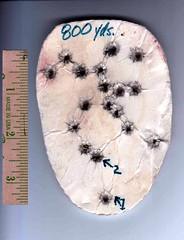I've straightened bullet runout a very simple and easy way that doesn't change neck tension on the bullet. There are tools out there that do this; stay away from them. You'll first have to spin your ammo marking the high point of bullet runout just in front of the extractor groove on the body. Use one dot with a Sharpie for each thousandth the runout has; 4 dots for a .004" runout.
First, mic your loaded round neck diameter. For my 30 caliber cases, their neck diameter's about .338 inch.
Second, get a bullet puller that size. I've got an RCBS one with a collet for .338 bullets. Set it up in your press such that it'll just barely hold onto a loaded round neck with the case body about half an inch above the shell holder.
Third. put the loaded round up into the bullet puller then lightly tighten the collet with the dots facing forward towards you.
Fourth, push in (away) at the dots such to slightly bend the case neck to about straight.
Fiftn, spin the round again to see how much straighter the bullet is.
Repeat these steps 'till all your ammo's got very straight bullets.
Depending on how ductile the case necks are, different amounts of force will be needed. Most folks will quickly learn how much force is needed to reduce runout a couple thousandths.
Used to do this a lot with Lake City match ammo as well as reloads for matches, Improved accuracy quite a bit. 30 caliber bullets with up to .003" runout need not be corrected. The limit seems to be .001" for each ten calibers of bullet diameter; a 40 caliber cartridge can have up to .004" runout; 22 caliber ones up to .0022".
Using bushing dies without expander balls is the best way to get straight case necks. With these dies, you can seat bullets with a ball peen hammer and they'll be very straight. If the case neck's bent, no bullet seater will make 'em straight; inline or whatever. RCBS and Redding make good ones. Sierra Bullets uses Redding full bushing dies to full length resize their cases used to test bullets for accuracy. They get best accuracy full length sizing; always have since the 1950's.
Note that straightening case necks must not change the relative seating of the bullets in the case neck. Bending things that support the round at bullet tip and case with pressure on the neck will change the neck's grip on the bullet. Using a collet like I explained doesn't change anything except where the case neck points relative to the case body axis.

